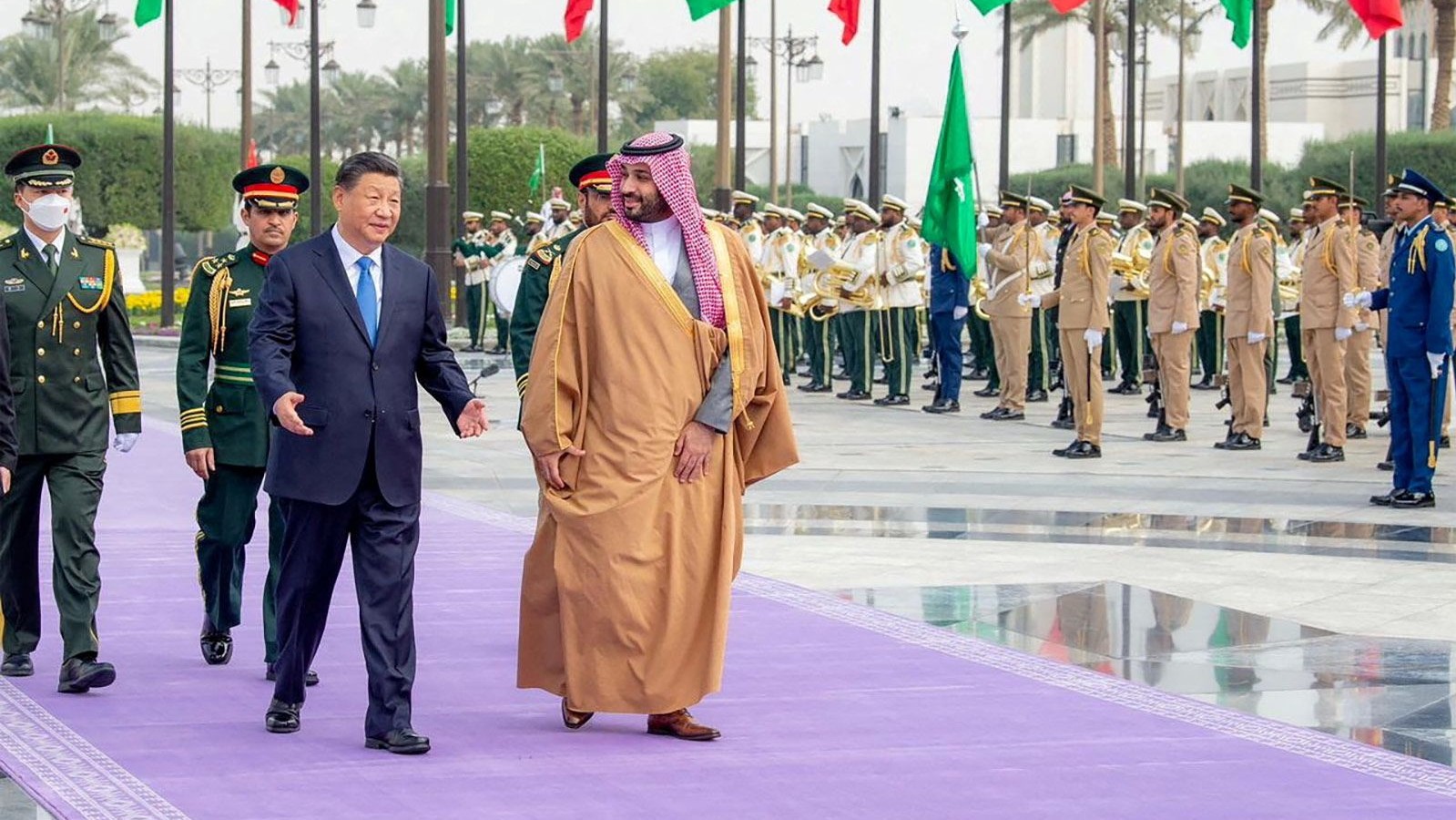Published 28 February 2023
Xi's proposed symbiotic relationship with some of the country's largest oil suppliers where China pays for its imports in renminbi is one in which the Western financial system need play no part. This could immunize both parties from Western sanctions, but is it enough to produce the breakthrough in yuan internationalization that China craves?
China has wanted to internationalize the renminbi for decades, but progress toward that goal has been painfully slow. According to the Society for Worldwide Interbank Financial Telecommunication (SWIFT) as of 2022, the renminbi ranked fifth, with a market share of more than 2%—slightly ahead of the Canadian dollar and behind the yen.[1] By way of comparison, nearly 42% of cross border payments used the US dollar for settlement while about 36% used the euro. The renminbi’s share has remained stagnant during the past few years.
SWIFT, of course, is a messaging service, not a settlement system. Its data captures all transactions that use the service, including a good share of China’s own China International Payments System (CIPS), but not, obviously, transactions involving economies that are currently under sanction, and therefore not using the SWIFT messaging service. As the list of countries under sanctions rises, the accuracy of data pertaining to the international use of the renminbi in trade diminishes. This means that estimates of renminbi usage in trade might be understated by a percentage point or so.
The Russian invasion of Ukraine resulted in severe economic sanctions imposed on Russia by Western and other countries. Russia therefore joined the list of oil-producing countries currently under sanction. Perhaps more importantly, the asset confiscations resulting from sanctions have augmented existing fears among some countries that they might be too dependent on the dollar system.
Against this backdrop, Chinese President Xi Jinping visited Saudi Arabia to meet Gulf leaders at the end of 2022. As Saudi Arabia’s relationship with the West has soured over human rights and Middle East policy, its ties with China have warmed. In Xi’s speech at the summit, he made clear of China’s Petro-Yuan ambitions and that China wished for a “new paradigm of all-dimensional energy cooperation” and that “the Shanghai Petroleum and Natural Gas exchange platform will be utilized for renminbi settlement in oil and gas trade.”[2]
Petroyuan as a challenge to the petrodollar
What Xi is proposing is a symbiotic relationship with some of China’s largest oil suppliers where China pays for its imports in renminbi. In return, China provides the capital goods and expertise to help Gulf economies pivot away from hydrocarbons. This is an economic relationship in which the US dollar and the Western financial system need play no part—immunizing both parties from the threat of US sanctions, positioning the petroyuan as a challenge to the petrodollar.
So, the question is: Will the increased use of sanctions by democratic countries, combined with closer geopolitical ties between China and the Gulf states, produce the breakthrough in renminbi internationalization that China craves?
To help understand why this might or might not be the case, it is helpful to step back and consider why the US dollar achieved its pre-eminence in international trade and financial flows in the first place. While there are myriad reasons, these five stand out:
- When Bretton Woods, the monetary management system devised by Western economies, collapsed in the early 1970s, the United States accounted for about 30% of world gross domestic product and 14% of world trade.[3] It also accounted for about 50% of world outbound FDI flows.[4] It was therefore the dominant global economy and largest international player.
- The US dollar was also freely tradable in an age when capital controls were common, and its value was market-driven, giving confidence to would-be holders of dollars that its value reflected broad supply and demand conditions.
- The US was a relatively open market for exporters and was prepared to run current account deficits, making dollars relatively easy to earn through trade. As the dominant global investor, the US could make dollars obtainable through the capital accounts too.
- The importance of the US as the economic hegemon led a large number of countries to set their exchange rates against the US dollar, either formally or informally, which meant they needed a stock of foreign exchange reserves in US dollars to smooth short-term fluctuations, making the US dollar the dominant global currency.
- The breadth and depth of US capital markets meant the dollar was the obvious currency for cross-border lending and capital-raising, and the US had the financial infrastructure to facilitate the worldwide use of the dollar.
Displacing the dollar as the dominant global currency
Clearly, some of the idiosyncrasies that led to the dollar’s dominance in international finance and trade have diminished. Capital controls have been vastly reduced or eradicated in large parts of the world with the exception of China. The US is no longer solely dominant in terms of investment or global GDP. China is the most important trading partner for the vast majority of countries, and this is particularly true in commodity trade. But would a “petroyuan” move the needle in terms of renminbi internationalization?
In 2021, prior to the Russian invasion of Ukraine, which boosted hydrocarbon prices and hence the value of trade, China imported just more than US$400 billion of mineral fuels.[5] This accounted for less than 2% of global exports, which totaled more than US$22 trillion. While Russia, Saudi Arabia, and Iraq were the three largest suppliers to China, US$45 billion actually came from the Western democracies: US, Australia, Canada, and the UK.
In addition to mineral fuels and related products, China imported US$270 billion of commodity ores.[6] About 40% by value came from Australia with the Global South accounting for much of the rest. Again, even in conjunction with fuels, if China achieved exclusive renminbi settlement for this trade, it would still not make significant headway in terms of displacing the dollar’s dominance of international transactions.
Renminbi as an attractive alternative
In 2021, total trade involving China (Chinese exports and imports) totalled more than US$6 trillion, or about 27% of world trade, but almost all exports were manufactured products that involved inputs from elsewhere.[7] China’s trade is heavily interlinked with North Asian trade partners (Japan, Korea, and Taiwan); with the EU; and the US. These trade partners are not particularly at risk of US sanctions and therefore have little reason to desert the dollar standard. Part of the logic of invoicing and settling trade in one currency is that intermediate participants in the supply chain can more easily manage revenue against costs by having certainty that both are denominated in the same currency, thus removing exchange rate risk. For the renminbi to gain significant market share in international trade, China will have to persuade its customers and suppliers of intermediate goods that it is more efficient to be paid in renminbi than dollars. That is a big ask for three reasons.
First, there must be a compelling reason to change. If the central bank digital currency or other innovations in cross-border payments offer substantial efficiency gains, that may help but the jury is still out. Second, the international value of the renminbi is untested by market conditions. This is because China’s capital controls and its central bank’s policy of closely managing the exchange rate mean that the prevailing exchange rate is not market-determined in the same way the dollar or the euro exchange rates are. Who knows what the exchange rate would be if all holders of the renminbi were free to dispose of them as they wished? Finally, the capital controls themselves potentially diminish the utility of holding renminbi. No one wants a large pool of liquidity that has conditions applied to its use.
The alternative route to significant market share gains for the renminbi in international transactions is through adoption by third countries for trade between themselves (for instance, Russia-Iran, intra-ASEAN, or intra-African trade). The best indication that this might be about to happen on any scale would be if such countries abandoned exchange rates set against the dollar or euro. That hasn’t happened yet.
If, as seems likely, China can import more of its oil and ores in exchange for renminbi, the yuan will have a greater role in the global trading system going forward. However, the market share gains will be relatively modest, perhaps taking the renminbi to a distant third in terms of share. However, to extrapolate that possibility into predicting the end of the dollar as the global reserve currency and preferred medium of exchange in international transactions seems far-fetched.
***
[1] SWIFT – renminbi tracker.
[2] China Daily: text of Xi’s speech at China-GCC summit.
[3] World bank database.
[4] UNCTAD database.
[5] Comtrade database.
[6] Comtrade database.
[7] Comtrade database.
© The Hinrich Foundation. See our website Terms and conditions for our copyright and reprint policy. All statements of fact and the views, conclusions and recommendations expressed in this publication are the sole responsibility of the author(s).




